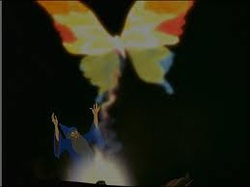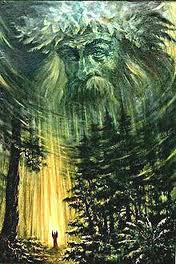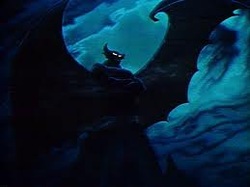Video clips for this section are on youtube.com
part 1 and 2
http://www.youtube.com/watch?v=MPDfP9eLTX4
http://www.youtube.com/watch?v=KGwPaQWPz3I
part 1 and 2
http://www.youtube.com/watch?v=MPDfP9eLTX4
http://www.youtube.com/watch?v=KGwPaQWPz3I
The Nutcracker suite, op.71.a: Fairies and spring awaking

In the very first section of Fantasia we are introduced to Disney showing us the awakening of the forest by the fairies and woodland spirits. This ties in with Slavonic pagan rituals with death because it shows awakening in spring and the coming of winter where nature sleeps and plants die to be reborn in the cycle of life. This is present in many argricultural societies and pagan groups. It is a part of yearly rituals.
The sorcerer's apprentice: death and rebirth

In my first scene of Disney's 1940 film Fantasia, I will discuss the similarity between the film, characters and how they relate to Slavonic Pagan gods, deities or ideas of death in their worldview. My first scene is the scene the sorcerer's apprentice. We see in this clip the sorcerer. He can make evil dark figures such as the first image of black creatures but he then can transform it into a beautiful butterfly. I believe this shows the belief in first nature spirits but also shows how many slavonic pagans and most of the world can see duality in nature and supernatural and death. Their gods can present good but there are gods who present evil or dark forces. These dualities are essential for balance in their worldview. It also represents the image of death and then rebirth through the evil form or deathlike form of the creature into a beautiful butterfly full of life. The death and re-birth cycle is present in many forms of paganism and agricultural based religions. It shows the relationship with the earth and harvesting times.
The rite of spring and nature gods

In the second scene we will look at the rite of spring scene. Here we see the earth changing the sun and waters and earth and reacting to the world. The subtitle to the composition of the "rite of spring" piece by Stravinsky was called " pictures from pagan russia". The composition was the idea of a young russian pagan girl sacrificing herself for the spring harvest festival where she dances till she dies. The whole composition follows the traditional rituals and rhythms put to music by Igor Stravinsky. The scene is in homage to Stravinsky's concept of music imitating the spring ritual but in Disney they add animation with nature. The sun in slavonic paganism can be represented through Belobog who is the god of light and sun. Veles is the image on the left he is a major god of the underworld, water and earth. These gods control the earth, sun, water and underworld they influence the world and are nature. It shows the connection of life and death present in slavic pagan worldview. The constant death of one organism leads to the rebirth and reformation of another at the will of the gods.
Night on Bald mountain and Chernobog

In the final scene of a night on bald mountain we are introduced to a character that is called "Chernobog" who is a slavonic pagan god. He represents evil, darkness. He is seen as just the opposite of Belobog the white god. It is unsure of his importance in the religion as a deity, god or demon. Many of the written folklore accounts are post christianization of the slavic areas. The case is Chernobog is seen as just an evil force and very negative usually associated with the darker side of death.
With his influence over the town he spreads darkness and calls up all ghosts and spirits to the mountain for a night of evil and mischief unattented by good spirits or positive forces. The spirits summoned are soldiers on horses and witches on brooms which can represent past spirits of war and death, witches like baba yaga, nymphs and grim reapers. They all represent death and dark forces.
We then are shown the demons and lower spirits dancing in darkness surrounded by flames from underground. They are delighting in the power of the Chernobog.They are then united with the fire which can represent death and rebirth. From the fire he creates nymphs meant to tempt traditonally people to darker more disinhibited actions. The fact that all the creatures return to the fire show the dualistic nature of pagan traditions, the balance of negative and positive forces. They are lower darker forces but have equal time as positive lighter forces. It is the cycle oflife and death. This is shown through the white light and sound of bells. The bell sounds represents a church but the white light can represent the whiteness of Belobog the white god. The exact opposite of Chernobog. Their names are represented in this "Bel" root for white and "Chorn" root for black and "bog" is the word for god. Their names literally mean black and white god. The white flashing all the creatures and Chernobog back to the darkness show the relationship of light and dark, death and life.
With his influence over the town he spreads darkness and calls up all ghosts and spirits to the mountain for a night of evil and mischief unattented by good spirits or positive forces. The spirits summoned are soldiers on horses and witches on brooms which can represent past spirits of war and death, witches like baba yaga, nymphs and grim reapers. They all represent death and dark forces.
We then are shown the demons and lower spirits dancing in darkness surrounded by flames from underground. They are delighting in the power of the Chernobog.They are then united with the fire which can represent death and rebirth. From the fire he creates nymphs meant to tempt traditonally people to darker more disinhibited actions. The fact that all the creatures return to the fire show the dualistic nature of pagan traditions, the balance of negative and positive forces. They are lower darker forces but have equal time as positive lighter forces. It is the cycle oflife and death. This is shown through the white light and sound of bells. The bell sounds represents a church but the white light can represent the whiteness of Belobog the white god. The exact opposite of Chernobog. Their names are represented in this "Bel" root for white and "Chorn" root for black and "bog" is the word for god. Their names literally mean black and white god. The white flashing all the creatures and Chernobog back to the darkness show the relationship of light and dark, death and life.
